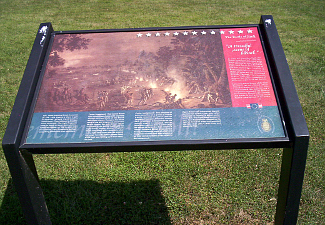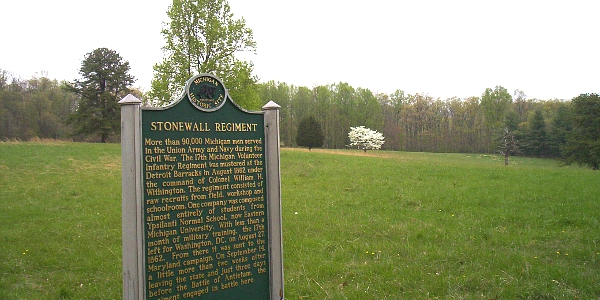America's Best History Spotlight
On this page we're going to Spotlight the lesser known historic sites and attractions that dot the history landscape across the USA and are worth a visit if you're in their area. And while they may be lesser known, some are very unique, and will be that rare find. You'll be, at times, on the ground floor, or maybe even know something others don't. It'll be fun. Visit them.

Battle of Paoli
A battlefield of significance. A massacre that would lead to the rallying cry "Remember Paoli" for battles of liberty to come. And it's all contained within this forty acre memorial to the men who fought against their British occupiers as they threatened to take over the capital of the nascent democracy in Philadelphia in their bold military move by ship south. Paoli followed the largest battle of the war at Brandywine one week earlier, and a thwarted, by tropical storm, battle a couple days before just down the road. And it would later lead to a Washington mistake that cost us Philly by the end of the month. Yes, all that history, and barely a drop in the heritage bucket about the American Revolution in almost all history books. So, once again, we discuss the battles of the war for freedom in a column about lesser known subjects. Boy, do we need a driving tour of this history, or what? Image above: Painting by Xavier della Gatta, 1782, of the Battle of Paoli. Courtesy Wikipedia Commons, Valley Forge Historical Society.
- Info
- What is There Now
- History Nearby
-

Battle of Paoli
It hadn't been a rout at the Battle of Brandywine on September 11, 1777, but it had been a defeat. So Washington retreated toward Chester, returning to his home base in Philadelphia to thwart another British attempt at the city if it came. The British stood their ground, remaining in the Brandywine Valley for the next five days. Eventually, both armies moved toward each other, coming close to another large engagement at the Battle of the Clouds on the 16th with weather causing Washington to retreat across the Schuylkill River with his main army, but leaving General Wayne and his division behind to harass British movements. Now comes the hard part, with an eventual acquittal in a court marshal stating that Wayne had acted properly, but others still questioning his actions. General Wayne did not place adequate pickets and guards as he made camp in Paoli, thinking he had gone undetected. However, General Howe's spies knew he was there. Even after warnings of a possible attack, the pickets that were augmented were inadequate. At midnight, September 20-21, twelve hundred British troops under General Charles Grey, with flints removed to remain undetected, attacked in three waves with brutal ferocity. It was a massacre. There were few prisoners; the British used bayonet for men just waking from sleep. Some men retreated into their wigwam structures to escape that death; they burned those men to death.
The number of casualties tells the aftermath story. Two hundred and seventy-two Continental soldiers were wounded, missing, captured, or killed (fifty-three killed by some accounts); only eleven total (four killed) for the British. General Wayne would retreat with the majority of his troops after that battle; he would meet up with General Washington, who had already made his mistake. Washington thought the British were heading to his supply bases and forges to the west and would soon be camping at Camp Pottsgrove. However, the British used the Paoli massacre as a cover for a feignt that would actually head east; they would take over the city of Philadelphia by September 26.
Today, the Paoli Battlefield stands as a memorial, with a quarter mile walking tour and wayside exhibits of the area of battle, as well as a Memorial, built in 1817, the 2nd oldest in the nation, atop the graves of the fifty-two men who died there. There are also memorials to soldiers from other conflicts. At the time, the memory of the brutality of British troops at the Battle of Paoli would create the first rallying cry in United States history. And at subsequent battles for the next four years, at Germantown, Monmouth, and beyond, they would scream, "Remember Paoli" as they fought.
Image above: Looking out over the Paoli Battlefield onto the walking trail and wayside exhibits.
-
Paoli Battlefield
What's There
Paoli Memorial Grounds. No visitor center here, but there are forty preserved acres with a quarter mile walking trail and wayside exhibits. There are three stops on a cell phone tour as well. Also, a Memorial dedicated to the men who died in the battle, as well as other memorials to other conflicts.
Forty acres of the park are open to visitors. There is a concerted effort to place the Paoli Battlefield on the National Historic Landmark list (it is already on the National Register of Historic Places), as well as to coordinate it with sites such as the Brandywine Battlefield and the Battle of the Clouds. These efforts are ongoing.
How Much to Visit
Free. On the weekend around the anniversary date of the battle, there is now a Paoli Battle Heritage Day, with soldier camps and other programs. There is a fee for this event.
Hours Open
Sunrise to sunset.
Where Is It Located
Paoli Battlefield Historical Park is located at Monument Avenue and Wayne Avenue, Malvern, PA 19355. It is easily accessible from Route 30, Lancaster Pike, or Route 3. The battlefield is approximately twenty minutes from both the Brandywine Battlefield or Valley Forge Historical Park.
Website - Paoli Battlefield Historical Park
-
Southeast Pennsylvania Historic Sites
So what else is there to do near the Paoli Battlefield? Well, there's the Brandywine River Museum of Art and Longwood Gardens near the Brandywine Battlefield, if you've begun your tour there.
Brandywine Valley Tourism
Other American Revolution sites exist all around the Philadelphia area as well, including the well known, Valley Forge and Independence Hall, and other lesser known, Fort Mifflin.
Brandywine Battlefield Park Associates
Valley Forge National Historic Park
Fort Mifflin







